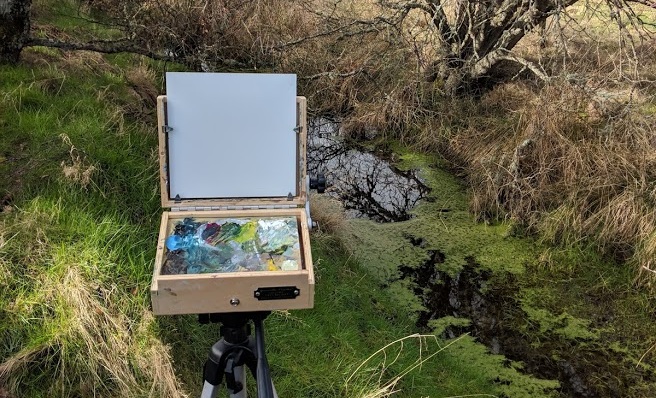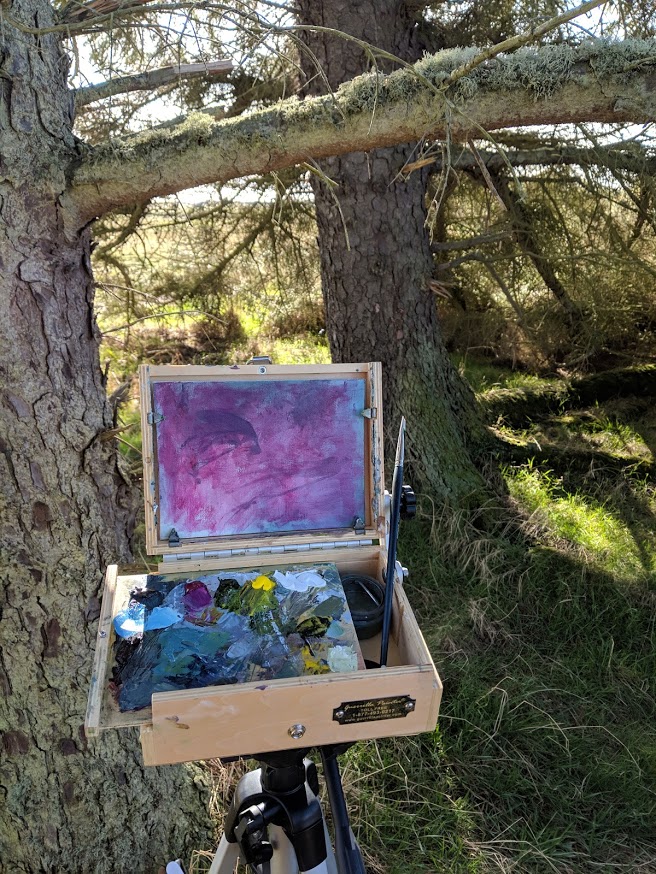125. Plein Air Painting at Evanton Beach & testing Ampersand Gessobord and Oil Of Spike Lavender
Sunny days have been rare lately, so it’s been tough to find windows of time for plein air (during days when I’m not fully booked).
We get a decent amount of sun, but it’s broken up by rain or snow and wind storms. Yesterday was the first day in a while where the sun stayed out for several hours (minus one short misting), so I took full advantage!
Monday's are usually a stream day, but I knew I had to take the opportunity, since I had been itching to test out the techniques I mentioned last week.
After I did my morning tasks, I packed up my gear and hit the road. I was lucky that my husband left his car at home while he was out of town for a business trip, so I was able to drop my heavy gear into the boot and drive to my location (normally it would take 45 minutes walk there).
I headed down the road to the “beach” - a long trail that hugs the Cromarty Firth. It was crazy windy, so I bundled up with lots of layers.
Another note: I have been frustrated with canvas lately. It’s what I’m used to, but it has never felt completely right for my plein air work. I love texture, but it has a way of distracting from the beautiful textures of the oil paint when I’m working this loosely. I only recently started to feel this way, so I decided to do some tests. The first painting of this session was on natural linen board. This second was regular canvas board. The third one was smooth gesso board (end of this post).
So anyways, my expectations were not that high due to the fact that I got rained out of my last four plein air sessions. I hoped for the best as I walked down the trail looking for a good spot. The sun dipped behind the clouds one moment, and shone brightly the next.
As I mentioned in the previous post, my rules were as follows:
Choose a spot within the first 15 minutes or less.
Use a limitted color palette.
Start off with a fast sketch with a dark pigment to capture the forms - no more than 5 minutes.
Paint in the light areas first.
Drop in bigger chunks of color to fill the rest of the canvas.
As I expected, as soon as I set up my stuff and started to mix paint, I was flooded with the usual sense of urgency. Was it going to rain? Would the wind blow my box over? How the heck will I paint THAT?
Admittedly, my first painting did not go well. I fell into the usual traps of my old ways, just frantically spreading paint. I completely forgot rules 3, 4, and 5.
I painted methodically from the background forward, and by the time I was done, felt defeated. It was ugly and the colors were off. It wasn’t until the very end of the painting that I noticed the sun was still out and it hadn’t rained, so suddenly I was inspired to quickly pack up and move to the next spot.
Biggest lessons learned:
Stop overblending the background. Use more muted colors. Slow down.
Natural linen panel
Onwards!
I wandered down the path and within 5 minutes, found my next spot.
I was painting over an old painting on canvas board, so I just used some thinned down magenta to cover the canvas.
So, I set everything up again, refilled my paint, and tried to really focus on the rules I gave myself.
This time it started to flow a little easier, and I found myself feeling wonderfully relaxed. There were a few moments of frustration - mostly in how to render color. I know this will take time and practice, so I was patient.
I stopped berating myself about getting things wrong and focused on what I was doing right and what I liked about the painting. Once I changed my mindset, it was a joyous activity again.
I took time to step back, view it from a distance, correct small things, but most of all, really try to capture the rugged beauty I saw in this small grove and the magic of the light.
Lessons learned:
Continue working on color accuracy. Minimize areas of complication (like huge bushes/areas with hundreds of brances).
After this painting, I was feeling much better. There was a growing awareness that method is extremely important, almost as important as understanding the fundamentals (color/value/etc).
Without a working method (like how you apply paint, layer things, etc) your knowledge of color and value and composition almost become useless.
Having a strategy for what you paint first, second, last can make the painting process go much smoother and allow you to focus on the important things, rather than cause you to struggle (like I was doing).
The problem is, finding a method that works for you takes tones of time and repetition, trying new things along the way. I have read hundreds of blogs and forums about methods, but it doesn’t matter until I put brush to canvas.
With this in mind, I eagerly packed up and walked down the path in search of my next subject.
I almost missed it, but I am glad I spotted this little stream. I loved the contrast of the water, reflections, green algae, gnarly tree, and mountains in the distance. (and I will definitely return here again!)
After setting up, I REALLY forced myself to think about the rules I layed out. This was the smooth gesso board (Ampersand Gessobord) and I decided to tone the canvas by mixing a little burnt umber and raw umber.
I had just received some Chelsea Classical Studio Oil Of Spike Lavender Solvent as a gift and wanted to fully test it out.
Boy was I in for a surprise!
First, I thinned down the paint with the oil, and the aroma was SUPER strong. But contrary to what I read online, I loved it. Yes, it was extremely powerful, but most of the scent was carried away by the wind, leaving behind a very pleasing aroma. Anyways, what I really loved was the instantly smooth and almost slippery texture of the paint, allowing me to very quickly spread it over the canvas and tone it down.
Example of the toned background.
I had read online that it can easily cause unwanted lifting in subsequent layers, so it’s better to use it for the first wash/sketch. I obeyed. After dropping in my initial sketch I was pleasently surprised by the gesso board’s properties. Because there was no textured canvas fighting against my brush’s bristles, I was able to scrub, draw, swipe, scratch, and play with the paint in new ways. It revealed everything I did, and I was instantly in love.
The combination of the thinned down paint and the revealing nature of the panel was everything I had been looking for. New doors were opening.
It might help to point out that when I’m doing plein air, I’m not aiming to get an exact likeness of my subject (a camera does that just fine). I am trying to capture the feeling of being there. Yes, I want to get some kind of accuracy, but mostly I need to convey to the viewer what it felt like in that moment.
How do you paint the feeling of wind? Or the sound of water in a stream? Or the grasses and thorns scratching your legs as you walk through the field?
It’s a task I will be tackling for the rest of my life. But for the first time in a long time, I felt like my materials weren’t battling against my will so hard.
As I packed up and headed back to the car, I had so many ideas flooding my mind. New things were awoken during this session that I can’t wait to poke and prod again. I have this newfound excitement in my practice!
A final thought about the Spike of Lavender oil: As I mentioned, it is extremely powerful. I kept it contained in a sealed bottle and used it sparingly during these paintings.
When I returned to my studio, I set the paintings out to “dry” in our spare bedroom (which is just our storage room because it’s so tiny). Since the lavender oil slows dry time, I don’t expect my paintings to be touch-dry for at least a week, so they need to be kept away from the cat.
I cleaned up my pochade box, closed it, and set it on the shelf in my studio.
The next morning when I walked into my studio, there was still a faint scene of lavender (which as I said, I love). However that just goes to show you that this stuff is incredibly strong and therefore I have concluded I will not use it indoors. It was still better than any other solvent I have tried. I am highly sensitive to solvents and most powerful odors, and cannot use them in my studio. Even galkyds make me feel dizzy.
If this is a concern for you, I can tell you what I do.
I mainly paint with “naked” paint in the studio - meaning I don’t add anything. However in the case where I do need to thin down my paint, or want to speed up dry time, I have found that Gamblin Solvent Free Gel is the only thing that doesn’t make me dizzy or feel sick, and it works beautifully. They also have a fluid version if you want less texture.
When I use it, I do have a fan next to me blowing it away from me, and the window is cracked.
I also really enjoy safflower oil, which is a nice way to clean brushes. I use it along with the 2-rag cleaning system, and end the session with soap and water.
Remember to stay safe and healthy! Do what is right for you :)






